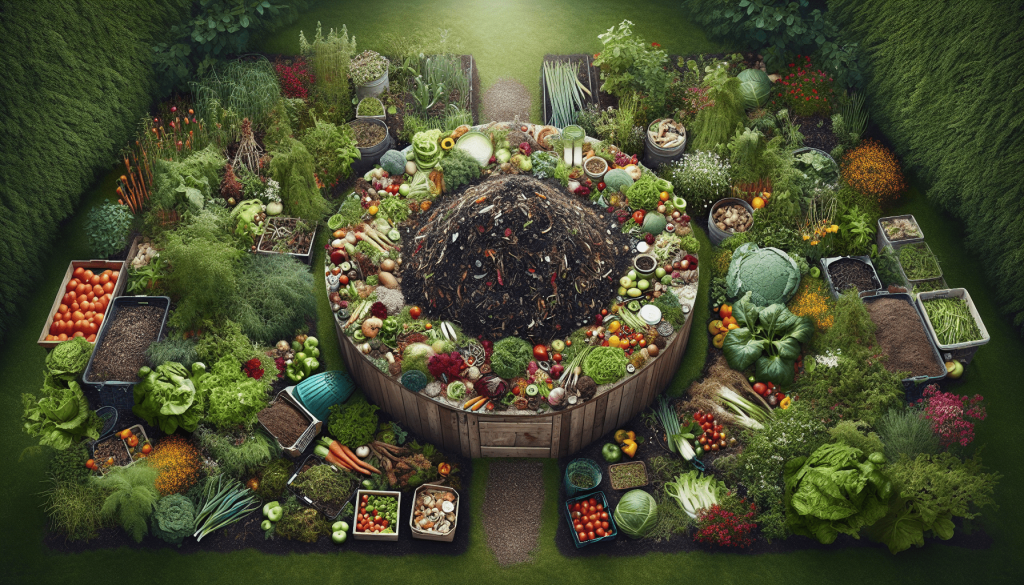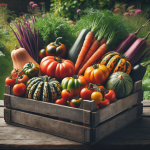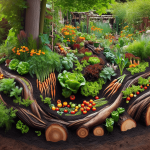This post may contain affiliate links. As an Amazon Associate, we may earn commissions from qualifying purchases.
You’re on a journey to give back to the earth and nourish your garden in the most sustainable way possible—by creating your very own organic compost at home! This guide is your friendly companion on this green adventure. From kitchen scraps to yard waste, you’ll uncover the secrets to transforming everyday throwaways into garden gold. Composting isn’t just a fantastic way to minimize waste; it’s also a gift to your garden, enriching the soil with vital nutrients plants love. So, let’s embark on this fulfilling journey together and turn your compost dreams into reality.
Understanding Composting
Definition of composting
Composting is a process that transforms organic waste materials into a nutrient-rich soil conditioner through natural decomposition. It’s an eco-friendly way to recycle kitchen scraps and yard waste, turning them into valuable food for your garden. By managing this natural process at home, you can significantly reduce your household waste and contribute to a healthier environment.
Benefits of organic compost
Using organic compost in your garden brings a myriad of benefits. It improves soil structure, increases moisture retention, and provides plants with essential nutrients for growth. Furthermore, compost aids in suppressing plant diseases and pests, reducing the need for chemical fertilizers and pesticides. By enhancing the overall health of your garden, organic compost not only supports plant life but also promotes biodiversity.
The science behind composting
The magic of composting lies in its ability to harness the natural process of decomposition. Microorganisms such as bacteria, fungi, and actinomycetes, along with larger organisms like earthworms and insects, break down organic matter into simpler substances. Oxygen plays a critical role in this aerobic process, allowing microbes to thrive and decompose material efficiently. The right balance of green (nitrogen-rich) and brown (carbon-rich) materials, moisture, and aeration is key to maintaining a healthy, active compost pile.
Choosing a Composting Method
Traditional composting
Traditional composting involves layering green and brown materials in a designated area of your garden. This method is straightforward and cost-effective, requiring minimal equipment. Periodic turning of the pile accelerates decomposition by introducing oxygen and ensuring uniform breakdown.
Vermicomposting
vermicomposting, or worm composting, uses specific types of worms to process organic waste into vermicompost. This method is ideal for indoor composting or small spaces. The end product is rich in nutrients and beneficial microorganisms, excellent for enhancing soil health.
Bokashi fermentation
Bokashi fermentation is a method that ferments organic waste in a sealed container using a specific inoculant. This process is odorless, quick, and can handle a wider variety of kitchen scraps, including meats and dairy, which are typically avoided in traditional composting. The resultant matter can then be buried in the garden to finish decomposing.
Comparing the methods
Each composting method has its unique advantages. Traditional composting is great for large volumes of yard waste, vermicomposting is suited for small-scale indoor setups, and Bokashi fermentation fits those looking to compost all kitchen waste. The choice depends on your space, needs, and types of waste you produce.

Setting Up Your Composting Area
Selecting a location
Choose a convenient yet discreet spot in your garden for the compost pile or bin. It should be easily accessible, but not too close to your living areas to avoid any potential odors. Make sure the site has good drainage and is Partially shaded to keep the pile from drying out too quickly or overheating.
Choosing a compost bin
The market offers a wide variety of compost bins to suit different needs and budgets. Closed bins are great for deterring pests and retaining moisture, while open bins or piles are easier to turn and aerate. Consider the size, material, and whether you’ll need to access the compost from the bottom when making your choice.
DIY compost bin options
Building your own compost bin can be a cost-effective and customizable option. Materials such as wood pallets, wire mesh, or even repurposed trash bins can be transformed into functional compost bins. DIY bins can be tailored to fit your space and composting needs perfectly.
Ingredients for Organic Compost
Greens vs. Browns ratio
Achieving the right balance between greens (nitrogen-rich materials like kitchen scraps and lawn clippings) and browns (carbon-rich materials like dry leaves and straw) is crucial for a healthy compost pile. A general rule of thumb is to aim for a ratio of 3 parts browns to 1 part greens by volume.
Suitable organic waste
Almost all organic waste can be composted, including vegetable and fruit scraps, coffee grounds, eggshells, grass clippings, and leaves. These materials provide the necessary nutrients and structure for microorganisms to thrive and work efficiently.
Materials to avoid
Not everything should go into your compost bin. Avoid meat, dairy, and oily foods as they can attract pests and produce odors. Diseased plants, pet wastes, and treated wood or yard waste should also be excluded to prevent the spread of pathogens or chemicals into your garden.

Starting Your Compost Pile
Layering ingredients
Start your compost pile by layering browns and greens. Begin with a layer of browns for good airflow at the bottom, followed by a layer of greens. Add water to moisten the layers as you go. Repeat the layers until the pile reaches your desired size, finishing with a layer of browns on top.
Maintaining moisture
Your compost pile should be as moist as a wrung-out sponge. This moisture level is crucial for microbial activity. If the pile is too dry, add water gradually. Conversely, if it’s too wet, add more browns to absorb excess moisture and improve aeration.
Aeration techniques
Regularly turning your compost pile introduces necessary oxygen and helps speed up the decomposition process. Use a garden fork or a compost aerator tool to mix the materials thoroughly. This also helps to distribute moisture and heat evenly throughout the pile.
Maintaining Your Compost
Turning the compost
Turn your compost every few weeks to ensure adequate aeration and decomposition. This process also helps to break down larger pieces more uniformly and prevents the pile from developing an anaerobic, smelly center.
Monitoring temperature
A healthy compost pile will heat up due to microbial activity. Temperatures between 130°F to 160°F are ideal for effective composting. You can monitor the temperature with a compost thermometer to ensure the pile is active and decomposing as expected.
Adjusting moisture and aeration
If the compost pile is too wet, add browns, and if it’s too dry, add water or greens. Turning the pile regularly will also improve aeration. These adjustments help maintain the right environment for microbes to efficiently break down the materials.
Troubleshooting Common Issues
Compost pile not heating up
If your pile isn’t heating up, it might lack nitrogen, moisture, or proper aeration. Add more greens, water, and turn the pile to incorporate oxygen.
Odors
Bad smells usually indicate anaerobic conditions or too much moisture. Turn the pile to aerate it and add browns to absorb excess moisture and balance the compost.
Pests and rodents
To deter pests and rodents, avoid adding meat, dairy, and oily foods to your compost. Keeping the pile well-aerated and covered can also help prevent unwanted visitors.
Using Your Organic Compost
Determining compost readiness
Compost is ready to use when it’s dark, crumbly, and has an earthy smell. It should no longer heat up or resemble the original materials.
Harvesting your compost
Once ready, sift your compost to remove any large, uncomposted pieces, and return them to the pile for further breakdown. The fine, finished compost is now ready to enrich your garden soil.
Application in gardening
Incorporate your organic compost into garden beds, use it as a top dressing for established plants, or mix it with potting soil for container gardening. Compost not only feeds your plants but also improves soil structure and fertility.
Compost Tea
Benefits of compost tea
Compost tea is a liquid fertilizer made from steeping finished compost. It’s an excellent way to deliver beneficial microorganisms and nutrients directly to plant roots or leaves. Compost tea can boost plant growth and resilience against pests and diseases.
How to make compost tea
To make compost tea, fill a bucket with water and add a scoop of finished compost. Stir well and let the mixture steep for a few days, stirring occasionally. Strain the liquid, and it’s ready to use.
Application methods
Apply compost tea to the soil around your plants or use it as a foliar spray. It’s best used immediately after preparation to maximize the benefits of live microorganisms.
Legal Considerations
Local composting laws and regulations
Before starting your composting operation, check your local regulations. Some areas have restrictions on composting methods, materials allowed, and compost bin placement.
Best practices to avoid nuisances
To keep your composting efforts neighbor-friendly, maintain your pile properly to avoid odors and pests. Enclosing your compost, managing materials appropriately, and regular maintenance are all good practices.
Engaging with community composting programs
If home composting is not feasible for you, consider participating in community composting programs. These programs allow you to contribute organic waste and, in turn, receive compost for your gardening needs, promoting sustainability and community engagement.








